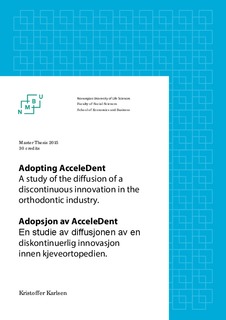| dc.description.abstract | This thesis examines the factors that affect the diffusion of the medical device innovation AcceleDent. The objective of the thesis is to make strategic recommendations that may drive the adoption of AcceleDent. These recommendations will be presented to the company, OrthoAccel.
According to established research and theory about diffusion, the perceived attributes and qualities of an innovation are among the most important factors affecting the rate of adoption. Diffusion theory also suggest that any given market consists of five different consumer segment: innovators, early adopters, early majority, late majority and laggards. Consumers are segmented based on their characteristics and values, which again determines when each consumer segment is likely to adopt an innovation.
The study was conducted using both quantitative and qualitative data about the consumers of AcceleDent, namely orthodontists. Secondary data from two surveys form the basis of the results, while primary data from observations and interviews allowed for a better understanding of the quantitative results. The purpose of the data collection was to examine the consumers’ perceptions of the benefits of AcceleDent, their interest in the device, and their method of implementing and using it. The data was also used to determine which of the above mentioned consumer segments we are dealing with, since my recommendations had to be based on the needs of the consumers.
My findings indicate that we are currently dealing with the early adopter and early majority segments. Reported concerns among orthodontists coincide with the theoretical characteristics of these segments, which suggests that consumers value established references when deciding whether to adopt an innovation. I found that orthodontists perceive a lack of established references, such as clinical evidence and detailed information about the device. Furthermore, orthodontists seem to perceive and value the product’s benefits differently. This has led to a variety of methods of implementing and using AcceleDent.
I recommend that the company conduct an in-depth study of the clinical and economic impact of AcceleDent. The results of the study should be used to educate orthodontists about the effects and benefits of AcceleDent, as well as how best to implement and use the device. This may decrease the uncertainty related to the device, and may increase the rate of adoption. | nb_NO |
